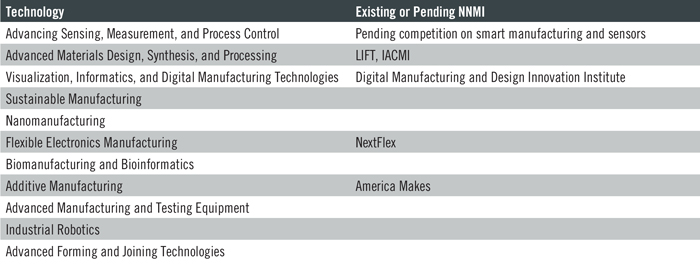Recently, The National Institute of Standards and Technology NIST announced the competition to award its first National Manufacturing Innovation Institute (NMII).
Proposers may focus on any advanced manufacturing technology area not already addressed by another institute or open competition. Seven institutes have been funded to date with two currently moving through the review and negotiation process. After attending the Proposer Day session on March 8, 2016, it is clear that many proposal teams have already been formed.
If you haven’t started organizing your proposal, then you may be too late for this competition. If you are interested in submitting a proposal or finding a partner, be sure to check out the NIST NNMI Federal Funding Announcement (FFA). Initial plans have called for 15 NNMIs, so more opportunities will become available. The 2012 report, Capturing Domestic Competitive Advantage in Advanced Manufacturing, identified 11 critical cross-cutting technologies and called for the establishment of the NNMI Network.If you are thinking about this NNMI or a future competition, the 2012 report and Table 1 provide a good start.
Table 1: Alignment of National Technology Needs and NNMLS

Summaries of the existing institutes and their state partnerships is provided below:
- America Makes, the National Additive Manufacturing Innovation Institute, Youngstown, Ohio, focusing on additive manufacturing/3D Printing technologies. (OH, PA, WV)
- Digital Manufacturing and Design Innovation Institute, Chicago, Illinois, focusing on integrated digital design and manufacturing. (IL)
- PowerAmerica—The Next Generation Power Electronics Manufacturing Innovation Institute, Raleigh, North Carolina, focusing on wide bandgap semiconductor based power electronics. (NC)
- Lightweight Innovations for Tomorrow, Detroit, Michigan, focusing on lightweight metals manufacturing technology. (OH, MI)
- Institute for Advanced Composites Manufacturing Innovation, Knoxville, Tennessee, focusing on advanced fiber-reinforced polymer composites. (TN, IN, MI, OH, CO)
- AIM Photonics—American Institute for Manufacturing Integrated Photonics, Rochester, New York, focusing on integrated photonic circuit manufacturing. (NY, CA)
- NextFlex, America’s Flexible Hybrid Electronics Manufacturing Institute, San Jose, California, focusing on the manufacturing and integration of semiconductors and flexible electronics. (CA, OH, TX, MA, GA, IN, AR, WA, MI, CT, AZ)
The NNMI program is more than simply a funding vehicle; it represents the one of the most ambitious examples of the Obama Administration’s efforts to create a new model of federal-regional partnership focused on generating and adapting to technological innovation.
Historically, America has employed two approaches.
- The first and oldest model is represented by national laboratories, which focus on national technology priorities and needs, but have low levels of regional engagement and are ambivalent to regional needs. This approach achieves national coverage in terms of projects, but it is less effective at aligning technology, workforce and economic needs simultaneously across diverse projects that are geographically dispersed.
- The second model, the Hollings Manufacturing Extension Partnership (MEP), is on the other end of the spectrum with regional organizations that are only nominally linked into a national network. This approach provides more alignment of technology, workforce and economic needs but it is slow to scale as each region re-invents the wheel.
The new NNMI framework calls for a multi-billion-dollar network of fifteen centers grounded in and leveraging regional clusters that form the backbone of an integrated national innovation ecosystem. Every technological innovation carries with it a unique set of opportunities and barriers which will affect all regions and industries differently. The NNMI network represents an opportunity to create something truly innovative that establishes a new model that balances both national and regional goals and objectives, while also providing more alignment of technology, workforce and economic needs.
There is a sound theoretical basis for this new model. Innovation, growth and change are rooted in people, firms and places. The growth of regional innovation clusters has demonstrated the power of this integrated approach. Research from the Brookings Institution and others have noted the importance of proximity and regional networks that can scale up for national impact:
…well-designed cluster and accelerator strategies—ones that require sizable local matches through competitive award processes—are a low-cost way to stimulate a significant amount of collaboration, innovation, and new economic activity in the local economic regions that are the ultimate source of national prosperity.[1]
The NNMI network then creates an opportunity to respond to national goals and objectives while increasing the capacity for sustainable growth. The budget for the NNMI program is much larger than that of the MEP program, but significantly smaller than those of the federal laboratories. Given the scale of their missions, the NNMIs will have to be smart about leveraging their capacity and resources. This will require regional partnerships so that projects and initiatives can be scaled up for national impact that will be sustained over time.
[1] Muro, Mark. Regional Innovation Clusters Begin to Add Up, Brookings Up Front

